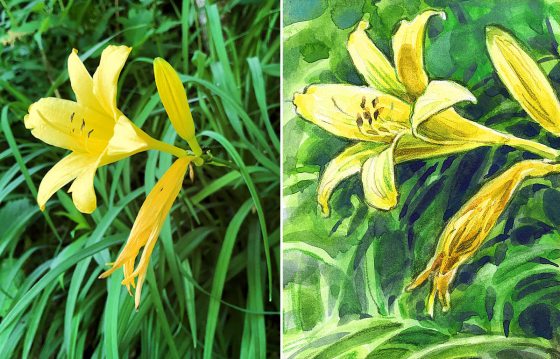Editor’s Note: In 2014, Vermont-based illustrator Natalya Zahn created more than 50 remarkable pieces of art that now appear on interpretive signage throughout our Meadow Garden. Deeply inspired by science and nature, Natalya’s unique illustration style blends accuracy with playful artistic expression, and her technical versatility is rooted in her meticulous eye for detail. Follow along as Natalya shares her expert field sketching tips.
A love of nature and keen eye for observation are two of the most important skills to use when approaching nature illustration. The more interest you have, the more you’ll want to investigate, and drawing is a fantastic way to internalize what you see. If you’re really invested in your subjects, it shines through in the art. Watercolor is a wonderful medium for those new to painting, as one can achieve precise detail and control, or let the liquid pigment work its own magic in brilliant watery washes.

Step 1: Assemble your field sketching kit.
Preferred art materials are highly individual but I typically pack with me what you see below.

Step 2: Select your subject.
For this exercise, I chose a daylily. Move around the subject until you find a vantage point that offers an appealing composition. Consider snapping a pic of that view for later reference and plant identification.

Step 3: Sketch your composition in pencil.
I use colored pencil because I can choose a hue within the palette I’m working with, and because it doesn’t smudge. Colored pencil also does not erase well, so my initial sketches tend to be very pale. To paint a plant in its environment I often start by blocking in the background. I begin with a medium value wash (in this case, green) and then build depth by layering in darker areas, defining foliage by filling in the negative space around it.

Step 4: Layer color washes.
I continue to work back and forth between the blossom and the background, layering color washes that heighten contrast and further define the edges of the lily.

Step 5: Hone in on details.
At this point, I bring back my colored pencils, edging around important areas of contrast, and bringing out fine botanical features.

Step 6: Admire your work!
About an hour later I’m ready to call it done.

Step 7: Clean up.
Make sure to rinse off your brushes before patting dry and packing them up and carry out used paper towels and any trash for appropriate disposal.

Looking for more inspiration? Listen along as Natalya shares insight into her style and more advice for creating nature illustrations of your own as part of our ongoing Longwood Voices series, or add your own flair with these Iris versicolor ‘Blue Flag’ and Liriodendron tulipifera (Tulip Tree) coloring sheets created by Natalya.


